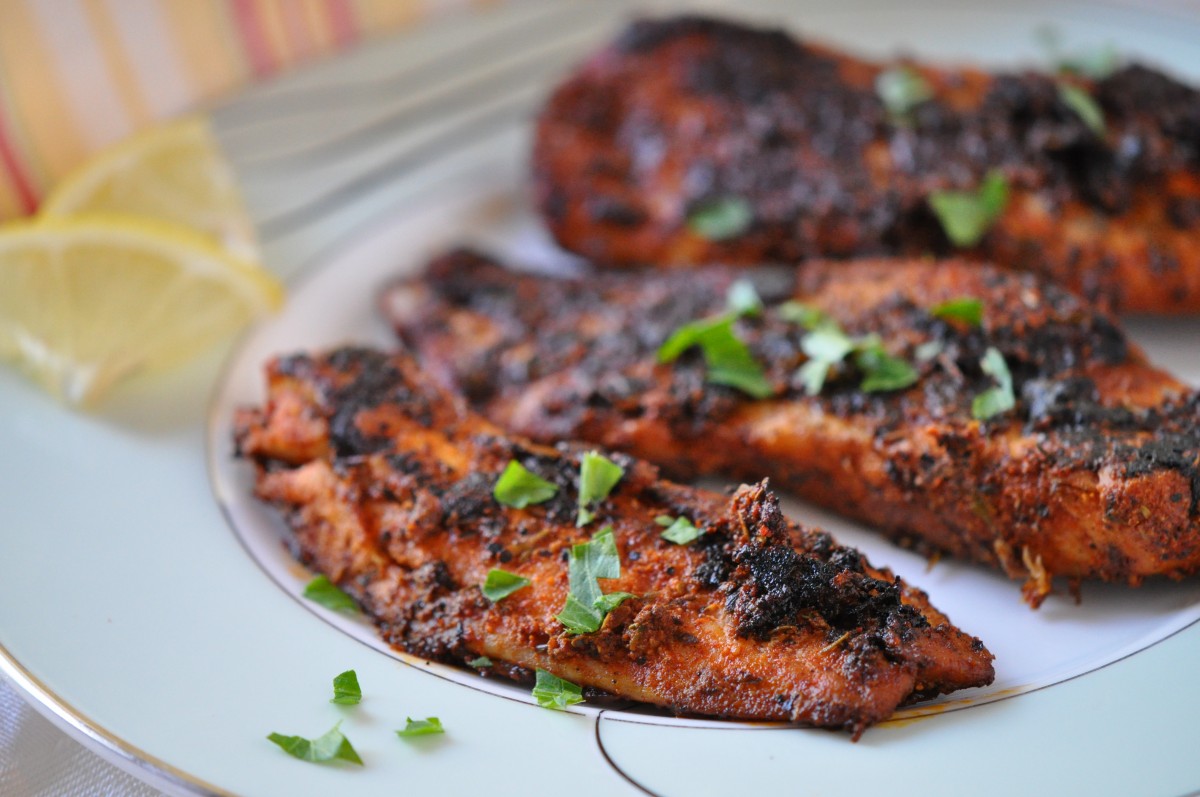Blackened Fish: A Guide to Cajun Cuisine and Its Health Benefits
Blackened fish is a dish known for its bold, smoky flavor and crispy crust. Chefs achieve this distinct taste by coating fish fillets in a blend of spices like paprika, cayenne pepper, and thyme, then cooking them in a hot cast-iron skillet. The high heat sears the spice coating, creating a blackened crust while keeping the inside juicy and tender. Popular fish choices include redfish, salmon, and catfish.
Origins of the Blackening Technique
The blackening technique originates from Louisiana and is closely associated with Cajun cuisine. Chef Paul Prudhomme popularized it in the 1980s. He sought a way to introduce robust flavors without excessive breading or frying. Using a specific spice mix and high-heat cooking method, he achieved a unique, flavorful crust that quickly gained popularity in American and global cuisines.
Key Ingredients for Blackened Fish
Essential Spices and Herbs
Blackened fish relies on a robust spice blend to create its signature flavor. You’ll use these spices:
- Paprika: This spice adds a sweet, earthy depth. Both sweet and smoked varieties work well.
- Cayenne Pepper: Delivers the dish’s signature heat. Adjust the amount based on heat preference.
- Thyme: This herb provides aromatic undertones, balancing the bolder spices.
- Oregano: Adds a slightly bitter, peppery taste for complexity.
- Garlic Powder: Enhances the overall savory profile.
- Onion Powder: Adds subtle sweetness and depth.
- Salt: Essential for enhancing all the flavors.
- Black Pepper: Complements the heat from cayenne, adding a sharp bite.
Best Types of Fish for Blackening
Selecting the right fish is crucial for successful blackening. Ideal fish include:
- Redfish: Traditionally used in the original recipe, it holds up well to high heat.
- Catfish: A Southern favorite, it’s firm yet flaky.
- Salmon: Rich in flavor, it complements the spice blend perfectly.
- Snapper: Mild and slightly sweet, this fish pairs well with the smoky spices.
- Mahi-Mahi: Firm texture makes it ideal for retaining moisture and form.
- Tilapia: Widely available and budget-friendly, it works well with blackening spices.
These key ingredients ensure that your blackened fish achieves the bold, smoky flavor and crispy crust characteristic of this dish.
Preparing Blackened Fish
Step-by-Step Cooking Guide
Start by gathering all ingredients. You’ll need your chosen fish fillets and a blackening spice mix. Ensure the fish fillets are dry by patting them with a paper towel.
- Preheat the Skillet: Heat a cast-iron skillet over high heat for about 5-10 minutes. The skillet should be extremely hot to achieve the desired sear.
- Coat the Fish: Brush both sides of each fish fillet with melted butter. Sprinkle a generous amount of the blackening spice mix on both sides, pressing the spices into the fish to ensure they adhere.
- Cook the Fish: Place the fillets in the hot skillet. Cook each side for about 2-4 minutes, depending on the thickness of the fillets. The crust should be dark and the fish should flake easily with a fork.
- Rest and Serve: Remove the fish from the skillet and let it rest for a few minutes before serving. This helps the juices redistribute within the fish, ensuring a moist and flavorful dish.
Tips for Perfect Blackening
Use Fresh Fish: Fresh fish ensures the best flavor and texture. If fresh fish isn’t available, thaw frozen fish thoroughly before cooking.
Temperature Control: Keep the skillet very hot. If the skillet cools down, the blackening effect won’t be achieved effectively.
Spice Evenly: Make sure the spice mix covers the fish fillets evenly. Uneven seasoning leads to inconsistent flavors.
Butter Quality: Use high-quality butter. It adds to the richness of the dish and helps the spices stick to the fish.
Ventilation: Cook in a well-ventilated area. The high-heat cooking method can produce a lot of smoke, so use an exhaust fan or open windows.
Follow these steps and tips to prepare blackened fish with a smoky, flavorful crust.
Cooking Tools for Blackened Fish
Skillet vs. Grill: What to Use?
Choosing between a skillet and a grill depends on your cooking setup and desired result. A cast iron skillet provides even heat distribution, keeping temperatures high, essential for creating a crisp crust. Skillets allow better control over heat levels and prevent fish from sticking. Cast iron retains heat well, helping to achieve the characteristic blackened texture. On the other hand, a grill imparts a smoky flavor, adding another layer of depth to the fish. Grills can handle multiple fillets simultaneously, making them ideal for larger batches. Each method has distinct benefits, so choosing one depends on your preference and equipment available.
Essential Utensils
Using the right utensils makes cooking blackened fish more manageable. A long, thin spatula designed for fish flip without breaking delicate fillets. Silicone brushes ensure even butter application, crucial for achieving a perfectly blackened crust. A heavy-duty oven mitt protects from high temperatures when handling hot skillets or grill grates. Invest in quality utensils to improve your cooking experience and results.
Choosing the Right Burner
Burner choice impacts cooking efficiency. Gas burners offer quick temperature adjustments, crucial for maintaining consistent high heat. Electric burners may struggle to reach and maintain the necessary high temperatures. For best results, use a gas burner or a high-powered portable burner. Consistent high heat ensures a well-blackened crust without overcooking the fish.
Thermometer Usage
Accurate readings help avoid undercooked or overcooked fish. Use an instant-read thermometer to check fish doneness, aiming for an internal temperature of 145°F (63°C). Instant-read models provide quick results, essential when cooking over high heat. Accurate temperature control guarantees perfectly cooked, moist blackened fish.
Ventilation Needs
Effective ventilation prevents kitchen smoke buildup. Use a range hood that vents outdoors, ensuring continuous airflow. For homes without a range hood, a powerful fan placed near an open window helps redirect smoke outside. Proper ventilation enhances cooking comfort and safety, allowing you to focus on creating a flavorful dish without smoke interference.
Health Benefits and Considerations
Nutritional Information
Blackened fish offers significant nutritional value. A typical serving (3.5 oz) of fish like red snapper, salmon, or catfish contains around 200 calories, 20 grams of protein, and various essential nutrients. Rich in omega-3 fatty acids, blackened fish helps support heart health by reducing inflammation and lowering triglyceride levels. Essential vitamins and minerals like vitamin D, B12, and selenium further contribute to overall well-being.
Dietary Benefits of Fish
Including blackened fish in your diet provides multiple health benefits. Omega-3 fatty acids found in fish enhance brain function and may reduce the risk of neurodegenerative diseases. High-quality protein supports muscle growth and repair, which is crucial for active individuals. Selenium in fish acts as a powerful antioxidant, protecting cells from damage. Eating blackened fish can also improve bone health, thanks to its rich vitamin D content, helping maintain calcium levels.
Conclusion
Blackened fish isn’t just a flavorful dish; it’s a celebration of Cajun culinary artistry and a powerhouse of nutrition. By mastering the technique at home, you can enjoy a restaurant-quality meal that’s both delicious and healthful. Whether you use a skillet or a grill, the key is high heat and quality ingredients. Plus, the health benefits make it a smart choice for any diet. So, fire up your burners, get your spices ready, and enjoy the rich, smoky taste of blackened fish right in your own kitchen.






